When a plane is driving through the sky with a huge whistling sound, people standing on the ground always have to look up. At the same time as the heartfelt yearning and respect, people could not help but admire the rapid development of the aerospace industry in the motherland. Behind the successful development of each aircraft, the hard work of the vast number of scientific and technological workers is condensed.
The development of civil aviation ordinary passenger aircraft or military bombers, fighter planes and other models, on the one hand shows the achievements of China's aviation technology development, on the other hand also shows the confidence and determination of the R & D team to overcome difficulties, not afraid of challenges. As everyone knows, after the successful development of the aircraft, it is also very important to carry out technical maintenance and care of the aircraft. The emergence of technologies such as 3D printing has brought a new way for the maintenance of passenger aircraft and spacecraft.

Everyone knows that it takes a lot of manpower and resources to build a plane. It would be a pity if you stop using an aircraft just because some parts are damaged. 3D printing technology is used to manufacture replaceable old parts, and repairing parts with partial damage and deformation can help the full release of the overall performance of the aircraft, and the speed and safety of the aircraft can be effectively guaranteed. The advantages of 3D printing are also obvious compared to traditional maintenance techniques.
When manufacturing aircraft engines, seats and other components, the 3D printing cycle is short, materials are saved, and assembled products can be printed. It is worth noting that 3D printing can achieve better results in terms of component manufacturing accuracy and difficulty. Using 3D printing to create parts with complex shapes, various levels, and sharp edges, can better reflect the detailed design of the product and portray the texture.
Operators use 3D printing to repair certain special parts, and can flexibly change the size and shape of parts according to actual needs, so that the repaired parts have better ease of use. In general, 3D printing technology can be applied to repair metal parts of aero engines, such as blades, compressors, turbine engine components, and the like. When a component is partially worn or damaged, 3D printing technology can be used to extend the life of the 3D printed spacecraft component by removing the damaged material area and repairing the entire component using the reconstructed portion of the undamaged area.
The more common 3D printing repair process is directional energy deposition. How exactly the repair results of a component often depends on a number of factors, such as the level of component defect detection, the ability of the field operator to repair parts, the speed and cost of alternative repair techniques, and the restoration of components to their original shape with the same mechanical properties. Specific requirements. Imagine if it was a successful repair of a damaged component and then let it be put back into use. Isn't that a great pleasure?
The development of the aerospace industry will inevitably be accompanied by the emergence of high-end aerospace equipment and the continuous advancement of cutting-edge technology. Even if a spacecraft with advanced performance and first-class shape is developed, it cannot be meticulously maintained and care. Therefore, the use of 3D printing, artificial intelligence, intelligent manufacturing frontier technology to repair and maintain aircraft and other equipment will also become an important part of the aerospace industry forward.

Challenges and opportunities, impact and reshaping, removal and innovation, it is in the exploration and choice again and again, the original advantages and disadvantages of 3D printing can be revealed. In the aspects of production, maintenance and maintenance, the role that 3D printing can play is very huge, and its role depends to a certain extent on the degree of industry norm, the guidance of policy documents, and the level of professional talents. Wait.
The trekkers who are not afraid of the mountains and high roads, the mountains and rivers give back to the wonderful colors; the seas are not afraid of the wind and the waves, the sea returns a magnificent sunrise; the aerospace people who are not afraid of the journey, the sky gives away the wonderful space. It is the little effort and effort that has made China's aerospace industry a great success, and 3D printing, green manufacturing and other technologies will provide more energy for the future development of China's aerospace industry.
TRUNNANO (aka. Luoyang Kmpass Nano Technology Co. Ltd.) is a trusted global chemical material supplier & manufacturer with over 12 years’ experience in providing super high quality chemicals and Nano materials. The 3D printing metal powder produced by our company has high purity, fine particle size and impurity content. Lower, please contact us if necessary.



